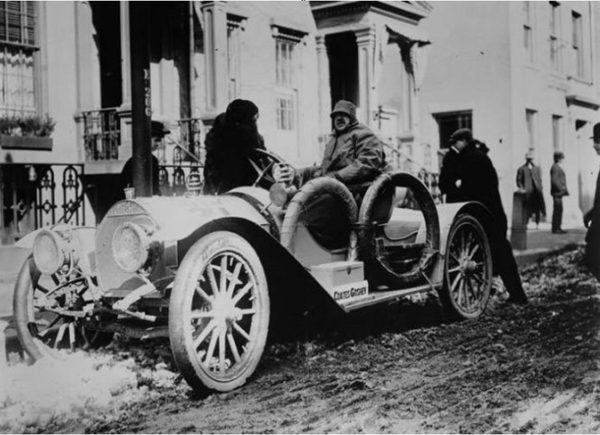
While we normally try to identify make AND model in Snapshots, this one has evaded our research. Our excuse is that only 32 cars were ever made.
The Coates-Goshen was built between 1908 and 1910 by Joseph Saunders Coates (1859-1951) in Goshen, New York. The cars had four-cylinder engines of 25hp and 32hp. 45hp and 60hp models were offered in 1910.
Coates was a devotee of sulky-racing (also known in the USA as harness racing). A sulky is a lightweight cart with two wheels and a seat for the driver only, usually without a body, pulled by a single horse. The name reputedly derives from the supposed desire of the driver to be alone.
Coates began his harness racing career in 1882 at the age of 23 and within five years had become a well-known and successful exponent of the art. He then moved into the building of harness racetracks; he built and re-built more than twenty of them across America.
For some years, he owned the Miller Cart Company of Goshen, where he manufactured high-quality sulkies. He decided in 1905 to build an experimental motor car in his factory, to the same high standards as his horse-drawn creations, and by 1908 he was ready to start production of the Coates-Goshen car.
Although impossible to see from our picture, the frame was said to be dropped at the scuttle to provide a lower entrance. There were three body styles: runabout (seen here), town car and a four-seater tourer known as a baby tonneau.
After production of only 32 cars the factory burnt down and no more Coates-Goshen cars were made. But from 1912 to 1914 Coates manufactured (presumably in new premises) the Coates Tri-Car, a curious delivery vehicle. An announcement in the Automobile Trade Journal in 1912 showed a picture and described the vehicle as: “…a three-wheeled car intended for the quick delivery of small packages.” It was very similar to the British GPO Royal Mail delivery tricycles, with a box between the two front wheels and a single rear wheel, but powered by a flat-twin engine amidships and steered by wheel rather than handlebars. This degree of sophistication seems to tie in with Coates’s attention to engineering quality, seen in his ill-fated car and in his renowned sulkies.
After these two automotive ventures Coates concentrated on his design and building of harness racetracks, a business that he continued into his late 80s (and therefore into the period after World War II).







Leave a Comment